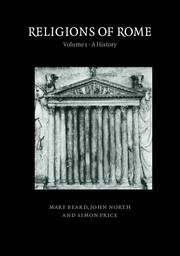Book contents
Summary
In A.D. 495 (or thereabouts) the Bishop of Rome sent a stern letter to some of his fellow Christians in the city, denouncing those who continued to celebrate the ancient ritual of the Lupercalia. Almost two hundred years after the emperor Constantine had started the process of making Christianity the ‘official’ religion of the Roman State, in a city that must in some ways have seemed a securely Christian environment (with its great churches — old St Peter's, St John Lateran — rivalling in size and splendour the most famous buildings of the pagan past), Bishop Gelasius was faced with the problem of an old pagan ritual that would not die. Many members of his flock watched eagerly, it seems, as every 15 February a group of youths, very scantily clad, rushed around the city (as similar groups had done for more than a thousand years), lashing with a thong anyone who came across their path. But these Christians were not just eager, interested or curious spectators. It was even worse than this from Gelasius’ point of view; for they claimed that it was vital to the safety and prosperity of Rome that this ancient ritual should continue to be performed - a claim that had always been one of the most powerful, and most commonly repeated, justifications of the traditional (pagan) gods and their cult. Proper worship of the Roman gods ensured the success of Rome: that was an axiom not easily overthrown, even by Christians in the late fifth Century A.D.
In mounting his attack, Gelasius looked back over more than a millennium of Roman history to the very origins of the Lupercalia - and to the prehistoric inhabitants of the seven hills, who invented the ritual (so Roman myths claimed) generations before Romulus arrived on the scene to found Rome itself. Gelasius may have publicly set himself against the traditions and mythologies of his pagan predecessors; but he knew his enemy and confidently appealed to the history of the institution he was attacking, spanning the centuries between Christian Rome and the earliest years of traditional Roman paganism. These are precisely the centuries that we explore in this book: the millennium or more that takes Rome from a primitive village to world empire and finally to Christian capital.
- Type
- Chapter
- Information
- Religions of Rome , pp. ix - xiiiPublisher: Cambridge University PressPrint publication year: 1998



